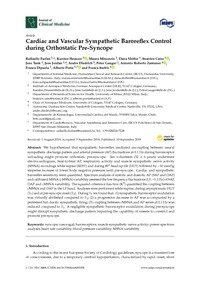Mostrar el registro sencillo de la publicación
Cardiac and vascular sympathetic baroreflex control during orthostatic pre-syncope
| dc.contributor.author | Furlan, Raffaello | |
| dc.contributor.author | Heusser, Karsten | |
| dc.contributor.author | Minonzio, Maura | |
| dc.contributor.author | Shiffer, Dana | |
| dc.contributor.author | Cairo, Beatrice | |
| dc.contributor.author | Tank, Jens | |
| dc.contributor.author | Jordan, Jens | |
| dc.contributor.author | Diedrich, André | |
| dc.contributor.author | Gauger, Peter | |
| dc.contributor.author | Zamuner, Roberto A. | |
| dc.contributor.author | Dipaola, Franca | |
| dc.contributor.author | Porta, Alberto | |
| dc.contributor.author | Barbic, Franca | |
| dc.date.accessioned | 2023-03-14T18:21:28Z | |
| dc.date.available | 2023-03-14T18:21:28Z | |
| dc.date.issued | 2019 | |
| dc.identifier.uri | http://repositorio.ucm.cl/handle/ucm/4503 | |
| dc.description.abstract | We hypothesized that sympathetic baroreflex mediated uncoupling between neural sympathetic discharge pattern and arterial pressure (AP) fluctuations at 0.1 Hz during baroreceptor unloading might promote orthostatic pre-syncope. Ten volunteers (32 ± 6 years) underwent electrocardiogram, beat-to-beat AP, respiratory activity and muscle sympathetic nerve activity (MSNA) recordings while supine (REST) and during 80° head-up tilt (HUT) followed by −10 mmHg stepwise increase of lower body negative pressure until pre-syncope. Cardiac and sympathetic baroreflex sensitivity were quantified. Spectrum analysis of systolic and diastolic AP (SAP and DAP) and calibrated MSNA (cMSNA) variability assessed the low frequency fluctuations (LF, ~0.1 Hz) of SAP, DAP and cMSNA variability. The squared coherence function (K2) quantified the coupling between cMSNA and DAP in the LF band. Analyses were performed while supine, during asymptomatic HUT (T1) and at pre-syncope onset (T2). During T2 we found that: (1) sympathetic baroreceptor modulation was virtually abolished compared to T1; (2) a progressive decrease in AP was accompanied by a persistent but chaotic sympathetic firing; (3) coupling between cMSNA and AP series at 0.1 Hz was reduced compared to T1. A negligible sympathetic baroreceptor modulation during pre-syncope might disrupt sympathetic discharge pattern impairing the capability of vessels to constrict and promote pre-syncope. | es_CL |
| dc.language.iso | en | es_CL |
| dc.rights | Atribución-NoComercial-SinDerivadas 3.0 Chile | * |
| dc.rights.uri | http://creativecommons.org/licenses/by-nc-nd/3.0/cl/ | * |
| dc.source | Journal of Clinical Medicine, 8(9), 1434 | es_CL |
| dc.subject | Syncope | es_CL |
| dc.subject | Vasovagal | es_CL |
| dc.subject | Baroreceptors | es_CL |
| dc.subject | Muscle sympathetic nerve activity | es_CL |
| dc.subject | Power spectrum analysis | es_CL |
| dc.subject | Heart rate variability | es_CL |
| dc.subject | Blood pressure variability | es_CL |
| dc.subject | MSNA variability | es_CL |
| dc.title | Cardiac and vascular sympathetic baroreflex control during orthostatic pre-syncope | es_CL |
| dc.type | Article | es_CL |
| dc.ucm.facultad | Facultad de Ciencias de la Salud | es_CL |
| dc.ucm.indexacion | Scopus | es_CL |
| dc.ucm.indexacion | Isi | es_CL |
| dc.ucm.doi | doi.org/10.3390/jcm8091434 | es_CL |



